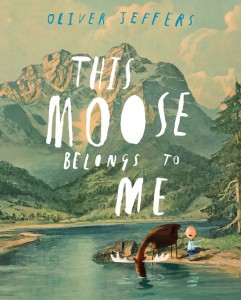March 12, 2013
A Message for Vickie from Reality Bites, with information she’ll already have been made aware of if she’s had children of her own.
When I was fourteen, I wanted to be you. I wanted your bangs, your vintage clothing, your string of sexual partners, and friendship with Winona Ryder. I wanted every one of my words to be so laced with irony, to be that cool. You made me want to smoke.
But what I longed for most was your talent for disdain. “My mother,” you told your friend, Winona, while she was filming that documentary about you and your rumpled slacker peers, “goes to the bathroom with the door open.” And I knew exactly what you were talking about. It wasn’t even about doors and mothers and bathrooms, though these certainly stood for something concrete and disgusting, but instead, it was about an entire way of life, the kind of person neither you nor I ever wanted to be.
Vickie, I thought about this again years later, a few weeks before I turned thirty, which is a good half decade older than you’ve ever been. It was three days after the birth of my first child, born by caesarean-section due to her stubborn insistence upon lying sideways across my uterus. She was perfect, my daughter, pink and swaddled in a Perspex box, and I was already going to the bathroom with the door open. And oh, Vickie, that’s not even the half of it.
That I was going to the bathroom at all was a significant milestone, open door notwithstanding. It meant not only had they taken my catheter out (and yes, Vickie, motherhood is really this transcendental), but I’d walked the eleven steps to the bathroom by myself, even though my abdomen had been sliced in two just 36 hours before. I felt like a superwoman, until it came time to pull up my underwear; Vickie, I just couldn’t do it. To bend over so far in this strange new world had become anatomically impossible.
This was, of course, the official moment when the magic died. I had to call for my husband, who’d been gazing dreamily at our sleeping daughter, and summon him to my aid. He would come in to discover me sitting on the toilet, crying with embarrassment and pain. I needed him to pull up my underwear, which was not only a beige mesh hospital-issued pair, but had a diaper-sized sanitary napkin cradled in its crotch, soaked with the kind of blood that only comes post-partum. Dear Vickie, it’s like no period you’ve seen.
There was no mystery between us after that. How could there have been? And in the months that followed, when I got into the habit of going to the bathroom with the door open because if the door was closed, my daughter cried, I thought of you again Vickie, how I’d let us both down, but also of how much I hadn’t known about life and love when I was fourteen years, and you neither, even though you’d been so much older.
See, it was you, Vickie, all along. How you broke your mother, then resented the damage. Turns out it’s not marriage and habit that are passion-killers after all, but instead it’s children. And it turns out also, which is such a revelation, that your mother doesn’t care what you think.
Love, Kerry
February 28, 2013
Brain, Child is back!
 February is almost quit, and while the great outdoors buried in snow and slush, I awoke to a fantastic email in my inbox this morning that is surely a sign of spring: it is time for me to renew my subscription to Brain, Child Magazine. This news all the more remarkable because the magazine folded last year, but it has since received new life with a new owner and editor. And so I was overjoyed to renew, and am excited to have Brain, Child return to my life. It’s such a smart, insightful magazine, and yet you’d not be remiss to read it in the bathtub. It’s the only parenting magazine out there that doesn’t fundamentally exist in order to make you buy stuff and feel bad about the condition of the cake-pops at your kid’s birthday party. According to Brain, Child, there’s no such thing as cake-pops at all. Which isn’t bad, in fact, it’s fine.
February is almost quit, and while the great outdoors buried in snow and slush, I awoke to a fantastic email in my inbox this morning that is surely a sign of spring: it is time for me to renew my subscription to Brain, Child Magazine. This news all the more remarkable because the magazine folded last year, but it has since received new life with a new owner and editor. And so I was overjoyed to renew, and am excited to have Brain, Child return to my life. It’s such a smart, insightful magazine, and yet you’d not be remiss to read it in the bathtub. It’s the only parenting magazine out there that doesn’t fundamentally exist in order to make you buy stuff and feel bad about the condition of the cake-pops at your kid’s birthday party. According to Brain, Child, there’s no such thing as cake-pops at all. Which isn’t bad, in fact, it’s fine.
So subscribe. You won’t be sorry.
Further, please read this article about the woman who makes a living from mediating between parents and Nannies. You will kill yourself laughing. It begins with James van der Beek’s wife, and goes on spout amazing lines like, ““I just don’t know if she has passion about Olivia.” Then, “I don’t feel safe when you throw a Lego at my head.” And features a woman who made a mission statement for how she wanted to raise her child. It is truly the best newspaper article that I have ever, ever read.
February 25, 2013
Eloise Wilkin's The New Baby (or, "The Blog Post That Cost Me $50")
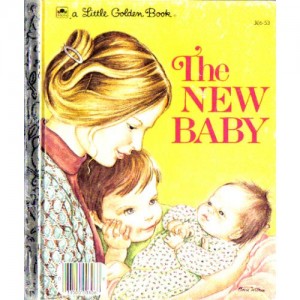 In November of 1981, my sister was born, when I was 2. The month before, according to to the note my mom made on the inside cover, I received from family friends a copy of The New Baby by Ruth and Harold Shane, illustrated by Eloise Wilkin. The New Baby became quite famous in our family as I memorized it entirely, and I’d amaze guests with my precocious “reading” skills. I have quite a vivid recollection of engaging with this book when I was very small, and when I read it now with Harriet, it’s not surprising that I loved it.
In November of 1981, my sister was born, when I was 2. The month before, according to to the note my mom made on the inside cover, I received from family friends a copy of The New Baby by Ruth and Harold Shane, illustrated by Eloise Wilkin. The New Baby became quite famous in our family as I memorized it entirely, and I’d amaze guests with my precocious “reading” skills. I have quite a vivid recollection of engaging with this book when I was very small, and when I read it now with Harriet, it’s not surprising that I loved it.
It’s something about Eloise Wilkin’s illustrations, I think. One of my other favourite childhood books was We Help Mommy, written by Jean Cushman, whose pictures still intrigue me now as much as they did 30 years ago. They intrigue Harriet too. It’s funny, because the illustrations were dated when I was small, and by now they’re probably about 70 years off, but it doesn’t make them any less engaging. Perhaps even more so? Because time has made these simple domestic tales become full of tiny mysteries (ie why do they clean the floor with a dust mop and not a vacuum?). These stories also show how the most essential parts of childhood never change.
 Anyway, I wanted to write about The New Baby, which my mom saved for many years and passed along to Harriet not long ago. Harriet is now absolutely obsessed with it too as we await the arrival of our own new baby a few months down the road. I like the book too, but the pictures fascinate me for different reasons, the uber-’70s fashions in particular. Check out the kitchen, with the cookbooks and lentils in jars up on the shelf, and whatever they’re eating out of a tagine. The copper pots! Mom’s billowy dress. On other pages, we encounter dad’s indescribably nasty suit (yellow with a blue and red print) and Aunt Pat’s brilliant red plaid pants and pink collegiate sweater at the end of the book. It turns out some things do change, and thank goodness…
Anyway, I wanted to write about The New Baby, which my mom saved for many years and passed along to Harriet not long ago. Harriet is now absolutely obsessed with it too as we await the arrival of our own new baby a few months down the road. I like the book too, but the pictures fascinate me for different reasons, the uber-’70s fashions in particular. Check out the kitchen, with the cookbooks and lentils in jars up on the shelf, and whatever they’re eating out of a tagine. The copper pots! Mom’s billowy dress. On other pages, we encounter dad’s indescribably nasty suit (yellow with a blue and red print) and Aunt Pat’s brilliant red plaid pants and pink collegiate sweater at the end of the book. It turns out some things do change, and thank goodness…
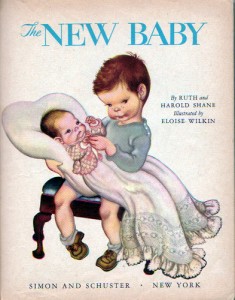 While I was googling to find images of the illustrations, however, I discovered that there was another version of The New Baby by Eloise Wilkin, and Ruth and Harold Shane. Turns out my book was a revised edition published in 1975, with updated illustrations. The original was published in 1948, and Wilkin’s drawings have a more-than-slightly-terrifying Norman Rockwell thing going on. Aunt Pat in this one is a hideous spinster with a crooked back, and in the kitchen there is not a lentil to be found. I was much intrigued by this, and really wanted to find out more about the original version of this book which was basically my literary foundation. It’s not in the library system but I tracked down a copy on AbeBooks, which should be coming my way in the next few weeks. I’m really looking forward to finding out the differences between the two.
While I was googling to find images of the illustrations, however, I discovered that there was another version of The New Baby by Eloise Wilkin, and Ruth and Harold Shane. Turns out my book was a revised edition published in 1975, with updated illustrations. The original was published in 1948, and Wilkin’s drawings have a more-than-slightly-terrifying Norman Rockwell thing going on. Aunt Pat in this one is a hideous spinster with a crooked back, and in the kitchen there is not a lentil to be found. I was much intrigued by this, and really wanted to find out more about the original version of this book which was basically my literary foundation. It’s not in the library system but I tracked down a copy on AbeBooks, which should be coming my way in the next few weeks. I’m really looking forward to finding out the differences between the two.
All this googling also directed me to the book Golden Legacy by Leonard Marcus, about the history of the Golden Books. (Apparently, I wrote about this book five years ago, though children’s books meant less to me then, which was probably why I never followed through so far as to actually read it.) As there is not a circulating copy of this book in the Toronto Public Library system, I was left with no choice but to order a copy for myself, which should arrive sometime this week. Very excited to encounter this one. Deirdre Baker’s 2008 review in the Toronto Star heightens my expectations.
Anyway, all this is how the quest to write this blog post ended up costing me 50 bucks. It’s going to lead to more blog posts though, and to new literary discoveries, and so I’m willing to bet that it all will be worth every penny in the end.
February 6, 2013
Pennies Saved
 I hate change of all sorts, except the monetary kind, and so I naturally am very unhappy about the demise of the penny. And so, in my efforts to render the penny eternal, I’ve decided to keep a glass jar full of them until the end of time (or at least until we decide to move, and I wonder if it’s really necessary to preserve a jar of pennies). I’ll display the jar high on a shelf, and one day I’ll show it to my grandchildren who will barely be able to fathom that there was ever such a thing as a one cent coin.
I hate change of all sorts, except the monetary kind, and so I naturally am very unhappy about the demise of the penny. And so, in my efforts to render the penny eternal, I’ve decided to keep a glass jar full of them until the end of time (or at least until we decide to move, and I wonder if it’s really necessary to preserve a jar of pennies). I’ll display the jar high on a shelf, and one day I’ll show it to my grandchildren who will barely be able to fathom that there was ever such a thing as a one cent coin.
But while all that is still in the future, my little daughter and I sat down this afternoon to sort through the coins in our family’s change jar and take the pennies out. And really, there is no better companion than a three-year-old for such a project. We had a very good time picking out the pennies and guessing if they were old or new based upon their shininess or tarnish. 2009 pennies we decided were Harriet pennies, “from the year you were born!” and pennies from the years after amazing because Harriet was older than they were. We were quite excited to find 1979 pennies too, as old as Dad and Mom. Lots of 1984, and 1992, commemorating Canada’s 125th. And then we found a 1969, which was exciting, and a 1967, which was the most exciting year of all. The oldest penny we found was from 1958, when the Queen looked remarkably young.
Our little jar isn’t filled yet, which means we’ll have to be keeping an eye out for pennies even as they become increasingly rare. In their rarity too, I think, they’re only going to become a little more magic, and really, haven’t they ever been?
January 30, 2013
On yarn, yarns and Extra Yarn
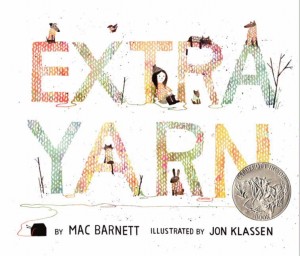 I’ve been knitting a baby blanket this last while, its colour yellow as selected by Harriet for whom yellowness is a sacred thing. And perhaps it was my current knitting project that got me thinking about the CanLit/Knitting Connection recently, about knitting in books and knitting about books. Then I thought about it more yesterday when we took out Extra Yarn by Mac Barnett and Jon Klassen from the library. What a spectacular book, about a little girl whose magical yarn stash never seems to run-0ut (and I know a lot of knitters, actually, with a similar affliction). I don’t know that Jon Klassen has ever gone wrong, and we loved this story with its splashes of colour, amusing prose, and sinister archduke (plus, SPOILERS, happy ending). Of course, you probably know all about this book already, especially since it was selected as a Caldecott Honour Book on Monday. Which was a particularly good day for Jon Klassen who also won the Caldecott Medal proper for the wonderful This is Not My Hat. I imagine this exciting news has changed Klassen’s whole life a little bit, but it’s changed mine too, because now I get to say that my website features an interview with a Caldecott winner.
I’ve been knitting a baby blanket this last while, its colour yellow as selected by Harriet for whom yellowness is a sacred thing. And perhaps it was my current knitting project that got me thinking about the CanLit/Knitting Connection recently, about knitting in books and knitting about books. Then I thought about it more yesterday when we took out Extra Yarn by Mac Barnett and Jon Klassen from the library. What a spectacular book, about a little girl whose magical yarn stash never seems to run-0ut (and I know a lot of knitters, actually, with a similar affliction). I don’t know that Jon Klassen has ever gone wrong, and we loved this story with its splashes of colour, amusing prose, and sinister archduke (plus, SPOILERS, happy ending). Of course, you probably know all about this book already, especially since it was selected as a Caldecott Honour Book on Monday. Which was a particularly good day for Jon Klassen who also won the Caldecott Medal proper for the wonderful This is Not My Hat. I imagine this exciting news has changed Klassen’s whole life a little bit, but it’s changed mine too, because now I get to say that my website features an interview with a Caldecott winner.
September 10, 2012
When this is all over…
 The latest in a series of strange objects I’ve found in the road, and actually on the same block as the “another Belfast man doing well” post-it. The story behind this one is even harder to discern, however. It’s actually a broken piece of plaster, painted on one side with a message etched in Sharpie with dubious grammar. I have this feeling it’s leftover from frosh week, as we live close to the university, and in that context, it makes total sense to me. I remember hating frosh week and hating so much about university as an institution, how adulthood was still so elusive, and how the bright spots in my world were a handful of kindred spirits. I probably would have written such a note to any of them, probably not on a piece of broken plaster, but perhaps it was the only surface available. I love how this broken piece of plaster manages to express the same love and longing of The Beach Boys’ Wouldn’t It Be Nice. Though I wonder how it ended up in the road, if the longing was unrequited, and the plaque’s recipient had had plans to get an apartment with another person altogether…
The latest in a series of strange objects I’ve found in the road, and actually on the same block as the “another Belfast man doing well” post-it. The story behind this one is even harder to discern, however. It’s actually a broken piece of plaster, painted on one side with a message etched in Sharpie with dubious grammar. I have this feeling it’s leftover from frosh week, as we live close to the university, and in that context, it makes total sense to me. I remember hating frosh week and hating so much about university as an institution, how adulthood was still so elusive, and how the bright spots in my world were a handful of kindred spirits. I probably would have written such a note to any of them, probably not on a piece of broken plaster, but perhaps it was the only surface available. I love how this broken piece of plaster manages to express the same love and longing of The Beach Boys’ Wouldn’t It Be Nice. Though I wonder how it ended up in the road, if the longing was unrequited, and the plaque’s recipient had had plans to get an apartment with another person altogether…
August 9, 2012
On Inger Ash Wolfe and my career failure as literary sleuth
 I thought I’d solved a literary mystery a few weeks back, completely by accident too. It was a Saturday morning and I was sitting at home in my pajamas putting up a new week’s main page at 49thShelf. A new book was out called A Door in the River by the pseudonymous Inger Ash Wolf, and the title seemed familiar to me. I could have sworn it was a song by Crowded House, which was intriguing. (Apparently if you want at least one reader and you want her to be me, you should name your next book Weather With You.) So I googled the title to discover that the Crowded House song I was thinking of was “Hole in the River”, but that was no longer the point once I’d stumbled on this page, a biography of Canadian writer Don Coles on the site “Canadian Poetry Online”.
I thought I’d solved a literary mystery a few weeks back, completely by accident too. It was a Saturday morning and I was sitting at home in my pajamas putting up a new week’s main page at 49thShelf. A new book was out called A Door in the River by the pseudonymous Inger Ash Wolf, and the title seemed familiar to me. I could have sworn it was a song by Crowded House, which was intriguing. (Apparently if you want at least one reader and you want her to be me, you should name your next book Weather With You.) So I googled the title to discover that the Crowded House song I was thinking of was “Hole in the River”, but that was no longer the point once I’d stumbled on this page, a biography of Canadian writer Don Coles on the site “Canadian Poetry Online”.
Inger Ash Wolfe, until more recently than the Saturday morning I’ve been referring to, was the pseudonym of a well-known Canadian literary author, and Door in the River was his/her third Hazel Micallef detective novel. And, as I discovered from the Don Coles biography, “A Door in the River” was also the title of a chapter from an unpublished novel by Don Coles, a chapter that was published in The Tamarack Review in 1964.
A strange coincidence, I figured. What are the odds? Further, Coles and Inger Ash Wolfe share a publisher, which published Coles’ literary novel Doctor Bloom’s Story in 2004. Inger Ash Wolf’s name has its Scandinavian edge, while Coles has spent time living in Denmark and Sweden. And no one else had ever guessed! It was amazing. So obvious, staring us all in the face (as long as we were looking at the Canadian Poetry Online website). I realized that Don Coles was hardly the biggest name in Canadian literary authors, but then all the more reason for the mysterious alter-ego, no? Perhaps Coles had forgotten about the Tamarack Review publication, nearly 50 years ago, when he’d resurrected his long-unpublished novel as a contemporary mystery, and kept the old title. Or maybe it was a clue, that he wanted us to find it. That Don Coles wanted to be found.
Perhaps it was Don Coles himself who’d set me loose that Saturday morning. I got dressed and my family consented to have me leave them, because I was off to solve a literary mystery after all. I am fortunate to have the University of Toronto’s Robarts Library at the end of my street, fortunate to have its opening hours include Saturday mornings in the summer. I was even permitted to enter the stacks, because my part-time instructor status comes with a library card. And so up I went to the 13th floor, which was dark and empty save for two students checking Facebook. When I came to the shelf where The Tamarack Review was stored, the lights switched on above me, almost as though the library knew I was there.
It was even on the shelf, albeit dusty, the issue I needed, from Summer 1964. Don Coles had published as “D.L. Coles”, alongside such notables as Margaret Laurence and George Jonas (and just in case you wondered when I was going to bring all this around to gender, there were two women contributors to eight male). Such a triumph, the book in my hands bringing me one step closer to the mystery’s solution. I was high on the smell of the stacks, bookish redolence I don’t get to experience so much now that I’m out of school. I was imagining that I was Maud Bailey. I wondered if I’d become a little bit famous.
The story itself though didn’t fit so well into the scheme. It was curious that Wolfe’s story of a small down Ontario female police detective had originated with this story of a failed architect in Florence in 1960. Coles’ story was mysterious, surely, full of gaps, but it wasn’t a mystery. I wondered… The key, I decided, would be the door in the river image. In Coles’ story the door is as literal as it is symbolic, a drowned door in a river in Florence, half-submerged, and “around it were squares of masonry and odd chunks of chimney, all that was left of the quartiere vecchio that the tidily retreating Germans had blown into the river with the bridges sixteen years before…”
So you can imagine that I was gutted two weeks ago when Michael Redhill outed himself as Inger Ash Wolfe, completely thwarting my dreams of professional literary sleuthdom. It was doubly frustrating because it was so predictable; Redhill had been suspected of Inger Ash Wolfing for ages. Whereas no one had ever suspected Don Coles, and the 1960s’ Tamarack Review connection. But alas, the answer that would make the best story (written by me, of course) can’t always be the right one.
June 8, 2012
A bouquet of maple leaves
 Taking these books back to the library today, and realizing that they do reveal a bit of a pattern in my borrowing habits.
Taking these books back to the library today, and realizing that they do reveal a bit of a pattern in my borrowing habits.
June 5, 2012
Library Owl
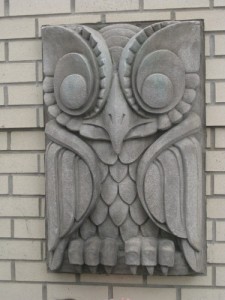 While I am quite familiar with the griffin and the lion flanking the entrance to the Lillian H. Smith Library, it was only today that I discovered the owl. It’s on the front of the building toward the west end, sort of hidden behind a sign on the sidewalk and I’d never noticed it before as I charged along the sidewalk, stroller in hand, hurrying home in time for lunch and nap-time. But Harriet has taken to walking, and as a result, our routes along the sidewalk have become much more meandering. Which is kind of annoying, but how brilliant when it yields a treasure. I have no doubt that wandering with Harriet will improve my city sight.
While I am quite familiar with the griffin and the lion flanking the entrance to the Lillian H. Smith Library, it was only today that I discovered the owl. It’s on the front of the building toward the west end, sort of hidden behind a sign on the sidewalk and I’d never noticed it before as I charged along the sidewalk, stroller in hand, hurrying home in time for lunch and nap-time. But Harriet has taken to walking, and as a result, our routes along the sidewalk have become much more meandering. Which is kind of annoying, but how brilliant when it yields a treasure. I have no doubt that wandering with Harriet will improve my city sight.
And just when I thought the Lillian H. Smith Library couldn’t be any more wonderful…
More: Joan Bodger and the Lillian H. Smith Library (see final paragraphs)


